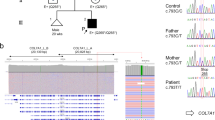Summary
Non-Herlitz junctional epidermolysis bullosa (JEB-nH), an autosomal recessive bullous genodermatosis, is characterized by generalized skin blistering from birth onward, dental anomalies, universal alopecia and nail dystrophy. The underlying defect is mutation of the COL17A1 gene encoding the type XVII collagen, resulting in losing structure for attachment of basal epithelial cells to the matrix. In present study, we described one case of congenitally affected female child aged 10 years, with skin blistering. Dermatologic examination revealed sparse, mild blisters on the face and hand, with profound enamel pitting of the teeth. Skin biopsy from proband’s bullous skin displayed subepidermal bulla formation without acantholysis. The immunofluorescence of anti-type XVII collagen antibody staining showed loss of type XVII collagen staining at the basement membrane zone. A combination of whole exome sequencing (WES) and Sanger sequencing revealed the novel heterozygous mutations (c.4324C>T;p.Q1442* and c.1834G>C;p.G612R) in COL17A1 gene, which could be associated with the observed JEB-nH. One allele had a novel nonsense mutation (c.4324C>T;p.Q1442*), resulting in nonsense-mediated mRNA decay and truncated collagen XVII; the other allele had a novel missense mutation of c.1834G>C;p.G612R in exon 22, causing a glycine-to-arginine substitution in the Gly-X-Y triple helical repeating motifs and decreasing the thermal stability of collagen XVII. Our findings indicate that the genetic test based on WES can be useful in diagnosing JEB-nH patients. The novel pathogenic mutations identified would further expand our understanding of the mutation spectrum of COL17A1 gene in association with the inherited blistering diseases.
Similar content being viewed by others
References
Nakamura H, Sawamura D, Goto M, et al. Analysis of the COL17A1 in non-Herlitz junctional epidermolysis bullosa and amelogenesis imperfecta. Int J Mol Med, 2006,18(2):333–337
Yancey KB, Hintner H. Non-herlitz junctional epidermolysis bullosa. Dermatol Clin, 2010,28(1):67–77
Has C, Spartà G, Kiritsi D, et al. Integrin a3 mutations with kidney, lung, and skin disease. N Engl J Med, 2012,366(16):1508–1514
Ashton GH, Sorelli P, Mellerio JE, et al. Alpha 6 beta 4 integrin abnormalities in junctional epidermolysis bullosa with pyloric atresia. Br J Dermatol, 2001,144(2):408–414
Li H, Durbin R. Fast and accurate short read alignment with Burrows-Wheeler transform. Bioinformatics, 2009,25(14):1754–1760
Li H, Handsaker B, Wysoker A, et al. The Sequence Alignment/Map format and SAMtools. Bioinformatics, 2009,25(16):2078–2079
Wang K, Li M, Hakonarson H. ANNOVAR: functional annotation of genetic variants from high-throughput sequencing data. Nucleic Acids Res, 2010,38(16):e164
Ng PC, Henikoff S. SIFT: Predicting amino acid changes that affect protein function. Nucleic Acids Res, 2003,31(13):3812–3814
Adzhubei IA, Schmidt S, Peshkin L, et al. A method and server for predicting damaging missense mutations. Nat Methods, 2010,7(4):248–249
Schwarz JM, Rodelsperger C, Schuelke M, et al. MutationTaster evaluates disease-causing potential of sequence alterations. Nat Methods, 2010,7(8):575–576
Chun S, Fay JC. Identification of deleterious muta-tions within three human genomes. Genome Res, 2009,19(9):1553–1561
Reva B, Antipin Y, Sander C. Predicting the functional impact of protein mutations: application to cancer genomics. Nucleic Acids Res, 2011,39(17):e118
Yang H, Robinson PN, Wang K. Phenolyzer: phenotype-based prioritization of candidate genes for human diseases. Nat Methods, 2015,12(9):841–843
Li Q, Wang K. InterVar: Clinical Interpretation of Genetic Variants by the 2015 ACMG-AMP Guidelines. Am J Hum Genet, 2017,100(2):267–280
Vaisanen L, Has C, Franzke C, et al. Molecular mechanisms of junctional epidermolysis bullosa: Col 15 domain mutations decrease the thermal stability of collagen XVII. J Invest Dermatol, 2005,125(6):1112–1118
Gelse K, Poschl E, Aigner T. Collagens—structure, function, and biosynthesis. Adv Drug Deliv Rev, 2003,55(12):1531–1546
Shoulders MD, Raines RT. Collagen structure and stability. Annu Rev Biochem, 2009,78:929–958
Xiao J, Cheng H, Silva T, et al. Osteogenesis imperfecta missense mutations in collagen: structural consequences of a glycine to alanine replacement at a highly charged site. Biochemistry, 2011,50(50):10 771–10 780
Floeth M, Fiedorowicz J, Schacke H, et al. Novel homozygous and compound heterozygous COL17A1 mutations associated with junctional epidermolysis bullosa. J Invest Dermatol, 1998,111(3):528–533
Shinkuma S. Dystrophic epidermolysis bullosa: a review. Clin Cosmet Investig Dermatol, 2015,8:275–284
McGrath JA, Gatalica B, Christiano AM, et al. Mutations in the 180-kD bullous pemphigoid antigen (BPAG2), a hemidesmosomal transmembrane collagen (COL17A1), in generalized atrophic benign epidermolysis bullosa. Nat Genet, 1995,11(1):83–86
Pasmooij AM, Pas HH, Jansen GH, et al. Localized and generalized forms of blistering in junctional epidermolysis bullosa due to COL17A1 mutations in the Netherlands. Br J Dermatol, 2007,156(5):861–870
Bauer JW, Lanschuetzer C. Type XVII collagen gene mutations in junctional epidermolysis bullosa and prospects for gene therapy. Clin Exp Dermatol, 2003,28(1):53–60
Bruckner-Tuderman L, Has C. Molecular Heterogeneity of Blistering Disorders: The Paradigm of Epidermolysis Bullosa. J Invest Dermatol, 2012,132(Suppl 3):E2–5
Lucky AW, Dagaonkar N, Lammers K, et al. A comprehensive next-generation sequencing assay for the diagnosis of epidermolysis bullosa. Pediatr Dermatol, 2018,35(2):188–197
Takeichi T, Liu L, Fong K, et al. Whole-exome sequencing improves mutation detection in a diagnostic epidermolysis bullosa laboratory. Br J Dermatol, 2015,172(1):94–100
Meienberg J, Bruggmann R, Oexle K, et al. Clinical sequencing: is WGS the better WES?. Hum Genet, 2016,135(3):359–362
Acknowledgments
We are thankful to the patient and her family for their participation in the study.
Author information
Authors and Affiliations
Corresponding author
Ethics declarations
The authors have no conflicts of interest relevant to this article to disclose.
Additional information
This work was supported by the National Natural Science Foundation of China (No. 81700032).
Rights and permissions
About this article
Cite this article
Yao, Yy., Zhang, Y., Xie, Xh. et al. Identification of a Novel COL17A1 Compound Heterozygous Mutation in a Chinese Girl with Non-Herlitz Junctional Epidermolysis Bullosa. CURR MED SCI 40, 795–800 (2020). https://doi.org/10.1007/s11596-020-2234-9
Received:
Accepted:
Published:
Issue Date:
DOI: https://doi.org/10.1007/s11596-020-2234-9




